Art in Healthcare | BTO Solicitors
Hillside View Art Sessions
Report by Jen Bradley
Background
The project at Hillside View Care Home in Paisley, funded by BTO Solicitors, consisted of total of 10 art sessions which were delivered by artist Jen Bradley. Two taster art sessions were delivered in both Edinburgh and Glasgow BTO offices, and 8 art sessions were delivered at Hillside View by the artist accompanied by two BTO staff members who volunteered during each session at the care home.
The unit at Hillside View specialised in Dementia care, more specifically for those living with Korsakoff Syndrome, which is a chronic memory disorder. Korsakoff syndrome causes problems learning new information, inability to remember recent events and long-term memory gaps. (See: https://www.alz.org/alzheimers-dementia/what-is-dementia/types-of-dementia/korsakoff-syndrome)
Taster Sessions at BTO Offices
The art sessions at the BTO offices in Glasgow and Edinburgh were an opportunity for BTO staff members to explore the various art materials that would be available to use at the Hillside View art sessions. [0.1] Art materials included watercolour pencils, acrylic paints and pastels. It was important for the volunteers to experience the feeling of sitting down at the art table, explore their own creativity and have a play with drawing and painting. For many people this does not come naturally and it’s common to hear that people have had negative experiences of art at school. This was an opportunity to turn any previous negative experiences into a positive one.
The aim of each session was to introduce those who were new to art materials, and to encourage those who were already familiar. There was no emphasis on producing a finished piece of work at the end of the session as to enable everyone to enjoy the process of mark making without the pressure of having a required outcome. This too would apply to the art sessions at Hillside View.
During the taster sessions, I talked about my experience of delivering art sessions within dementia units. I felt it necessary to prepare those who were to volunteer, and to inform those who weren’t volunteering, but who were interested in how their company was supporting the residents at Hillside View.

Art Sessions at Hillside View
The participant-led art sessions took place on a Sunday morning for 8 weeks. The aim of each session was to gently encourage each individual to explore their own creativity at their own pace. Providing artist quality materials, this project would differ from previous projects delivered at Hillside View as the sessions would be 1:1 within a group setting and participant led.
Every individual had the opportunity to explore the art material or book they were most drawn to and had the time and space to chat with an experienced artist and two volunteers. I asked the care home staff if there could be a maximum of 8 participants at any given time. When working with a group of individuals who all have varying stages of dementia, it is vital to keep the size of the group smaller. There are a few reasons for this: it can be sensory overload and very distressing for a person living with dementia when noise levels are high and too many people are in the same space; with only one artist experienced working within the care home setting and two volunteers inexperienced in working alongside individuals living with dementia, the participants attending wouldn’t have had the best support if there had been a larger group than 8.
Residents at Hillside View looked forward to the art sessions on a Sunday and many were waiting to begin before we had set up any of the art materials. Staff at the care home mentioned that previous to the Art in Healthcare art sessions Sundays were a very quiet day and that the residents were out of bed and feeling happier in general after they had been to the art session. Many of the participants grew in confidence over the course of the 8 weeks.
(Please see Case Studies 1, 2 and 3)
Volunteers
Two members of staff from BTO Solicitors volunteered at each of the 8 workshops at Hillside View. A rota was created to enable different members of staff to join the art session and experience how the residents were benefitting from the experience.
It was necessary to brief the volunteers in the morning while we were setting up for each session to make each volunteer aware of the layout of the area we were in and to mention notes on some of the regular participants. Some of the participants had the capacity to be aware of what they were working on from the previous week and some may not have remembered that they had ever been to the art session before. Being aware of the language used during the session was key because it could be very upsetting to ask somebody who has dementia to recall what they were working on the previous week. It was important to help each volunteer feel at ease in the unfamiliar setting, but also give them an indication as to how the previous workshop had gone.
I asked the volunteers if they could pass on to me information at the end of the session with regard to likes/dislikes and interests of the participants. This information was invaluable as it helped me to gather as much information as I could on the interests of the participants and meant that I could source postcards, books, imagery and materials according to the individual interests of each person.
In hindsight, I think that a longer set-up time was needed to accommodate for briefing volunteers and liaising with care home staff to establish if there was anything I had to be aware of with regard to the individuals before they joined the session. It was great that so many people volunteered to help at the Sunday art sessions although I wondered if it may have been of more benefit to the volunteers and to the residents if there had been more consistency to the people joining them each week. If the project had been longer it would have been helpful to have volunteers in for a number of weeks, and then rotate, so as not to be starting from the beginning at each session. It would have helped them to develop their understanding of the project and also allow for the residents to feel more comfortable around them.
Feedback from the volunteers was all positive with many saying that they really enjoyed the experience and that they hadn’t been involved in a project like it before. Having the support of the volunteers ensured the smooth-running of each session.
Feedback from Hillside View Staff
Staff mentioned that after the Sunday art sessions the residents who had been a part of the session were generally in higher spirits for the rest of the day. They said that the positive effect of the art session often lasted throughout the week, with many of the participants looking forward to the art session, wondering what they would like to paint on the Sunday. A couple of the gentlemen attending the sessions worked on drawings and paintings throughout the week.
Case Study 1
“L”
“L” said that she had been curious about the Sunday art session for weeks but had felt anxious about joining the group. One Sunday as she peered in to the room I gently encouraged her to come and have a look at the art materials we had. I explained to her that it wasn’t a class and that there would be absolutely no pressure to take part but if she felt like looking through some books or exploring some art materials then she could. After sitting down beside “J” and having a look at what he was doing with the acrylic paint “L” felt inspired and decided she would have a go herself. She was hooked; “L” joined us for every remaining art session as she enjoyed herself so much.
Every week I brought in different art books for the residents at Hillside View to look though. I asked “L” about what things she liked looking at or being around and she told me that she very much enjoyed looking at fields. I brought in a Van Gogh book for her to look at some paintings of fields and to let her see how interesting it can be when you can see the artist’s brush strokes within the painting. “L” was fascinated by all of the different tones of yellow depicted in this particular painting and wondered if she could apply this technique to her own painting. The sun room we were situated in looked out onto the garden where there were lots of plants. “L” decided to paint her favourite plant in the garden and asked me how she could make all of the different tones of green for its leaves. I showed her how she could use her palette for mixing colour and she mixed lots of variations of green to depict all of the tones she could see. [1.1]
The following week I showed “L” the set of pastels we had and explained how you can build up tone when using pastels on pastel paper. “L” loved the feel of the pastels and being able to smudge them on the page. [1.2]
“L” said that she was sad that the Sunday art sessions had come to an end but that she was so happy to know now how much she loves painting and drawing. She said that she wished she had joined the group sooner.
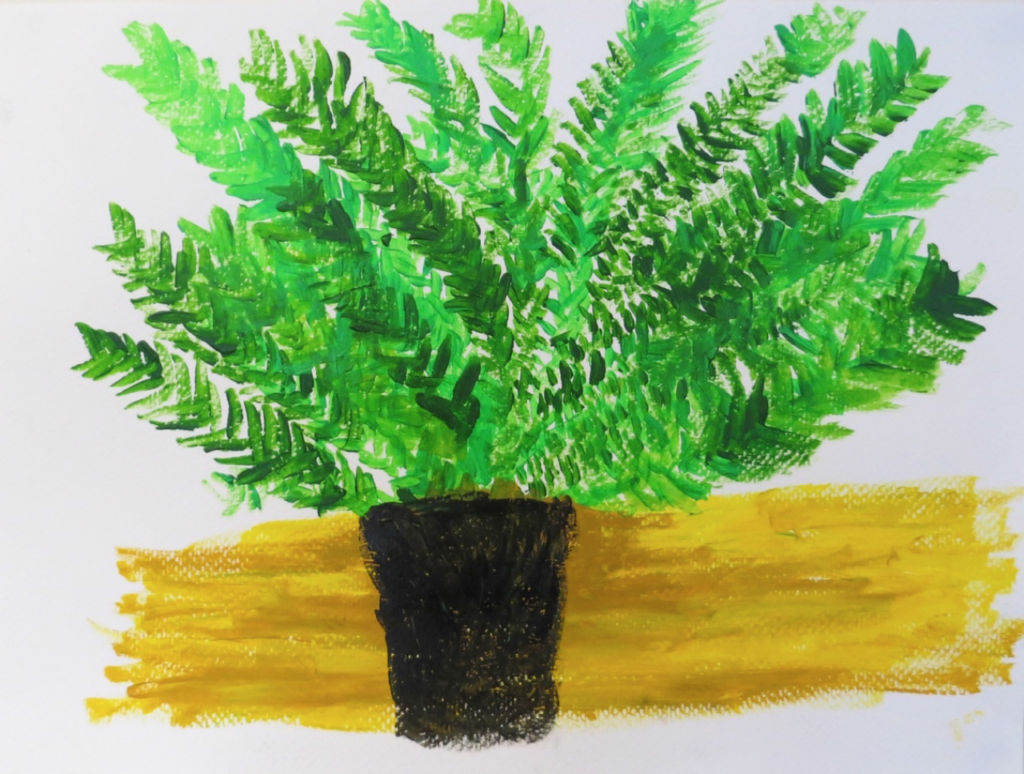

Case Study 2
“J”
One gentleman, “J”, attended every single Sunday art session. “J” didn’t regularly communicate verbally but asked initially if he could have a palette of “all the colours” of paint. I showed “J” what the acrylic paint looked like and his eyes appeared to light up at the intensity of the paint colour.
Acrylic paints are a great introduction to painting because, as a facilitator, it helps me to gauge cognitive ability when working with individuals who have varying forms of dementia. As the acrylic paint is already in liquid form, a dry brush can be used immediately to paint with; it can be confusing and upsetting for an individual with memory and/or visual impairment to comprehend the 3-step process of wetting the brush, dipping into a dry pigment then taking this pigment to the paper. What can often happen is the brush is dipped into the water and taken to the page, without the paint, leading to confusion and deflation.
“J” painted page after page of horizontal colour [2.1]. His work was an endless and energetic flow of creative practice. When finished each painting he would just say, “finished,” and I would ask if he would like to paint more. I wondered if he would like to paint on larger paper as he often opted for the chunkier paintbrushes. He painted on A4 watercolour paper, A3 watercolour paper and then onto A3 canvas boards – all vertical or horizontal colours. One day, after weeks of linear painting, he began to paint in a large scale circular motion [2.2].
This was a huge development, he was beginning to feel comfortable and more confident with the paintbrush.
I played music during the art sessions and on a few occasions and, near to the end of the block, I asked if anyone had any musical requests – “J” loved Neil Diamond. When Neil Diamond was playing, “J” began singing along and, sitting beside “L” who was painting a plant from life that day, “J” painted his own plant [2.3] too. This was an incredible moment as it was completely different to any of the other paintings that “J” had painted throughout all of the sessions.
If the sessions had continued I would have brought in some MDF board for “J” to try.

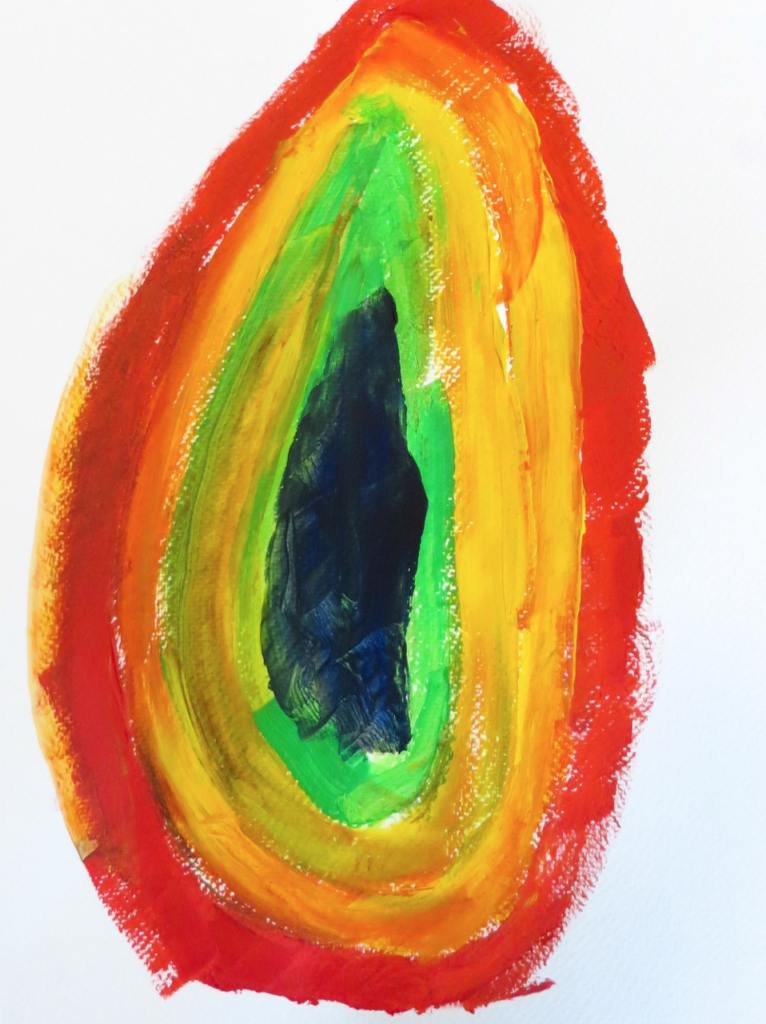
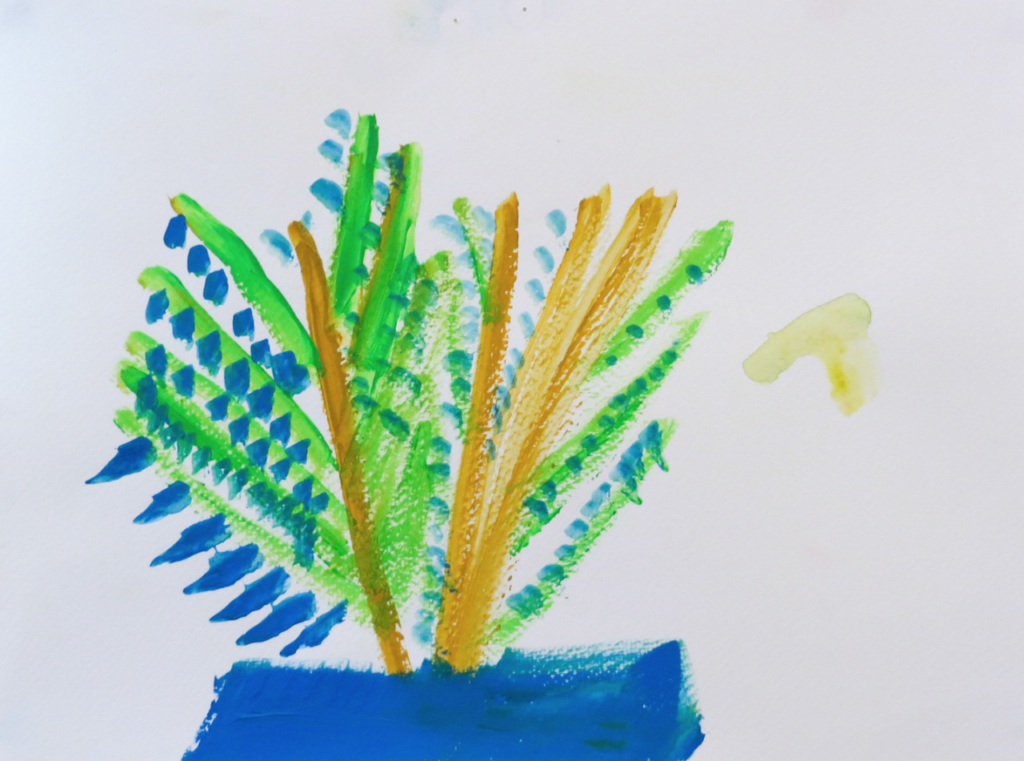
Case Study 3
“I”
During art sessions I leave out smaller bits of paper on the table so that there is always a piece of “scrap” paper readily available to try out a material on. I find it’s a gentle way to encourage an individual who is initially feeling unsure of making a mark at all. When “I” was brought to the art table by a member of staff, she appeared very sleepy and irritable. I wasn’t sure that she wanted to be there. I took over a set of watercolour pastels and asked if she had tried them before. She said that she hadn’t so I explained to her that when you add water to them that they turn into paint. I showed her on a piece of scrap paper that the colour becomes a lot more vibrant when you apply water over the top of it and she said that it was interesting, but that she didn’t like that colour. I asked if she could pick out a colour that she liked and that she could try that one on her own bit of scrap paper. She didn’t like that colour either, but she went on trying every single colour nonetheless and found that she had enjoyed the experience of applying colour to the page and watching how the colour grew more vibrant with water added.
I saw that she looked comfortable with a paintbrush and thought next time I would take over a small set of watercolour paints for her to try. “I” mixed up her colours in the palette of the paint set and tested them out in the bottom right hand corner of her page. [3.1] She began painting flowers, using small, delicate brush strokes. I asked “I” what kind of music she liked the next time she came to the session. I wanted to see if music could help her to feel calm and more relaxed in the room. She liked classical music so I played that gently in the background. What happened next was remarkable, “I” was able to focus on a painting for around an hour. [3.2] She told me that she had thoroughly enjoyed being able to paint.
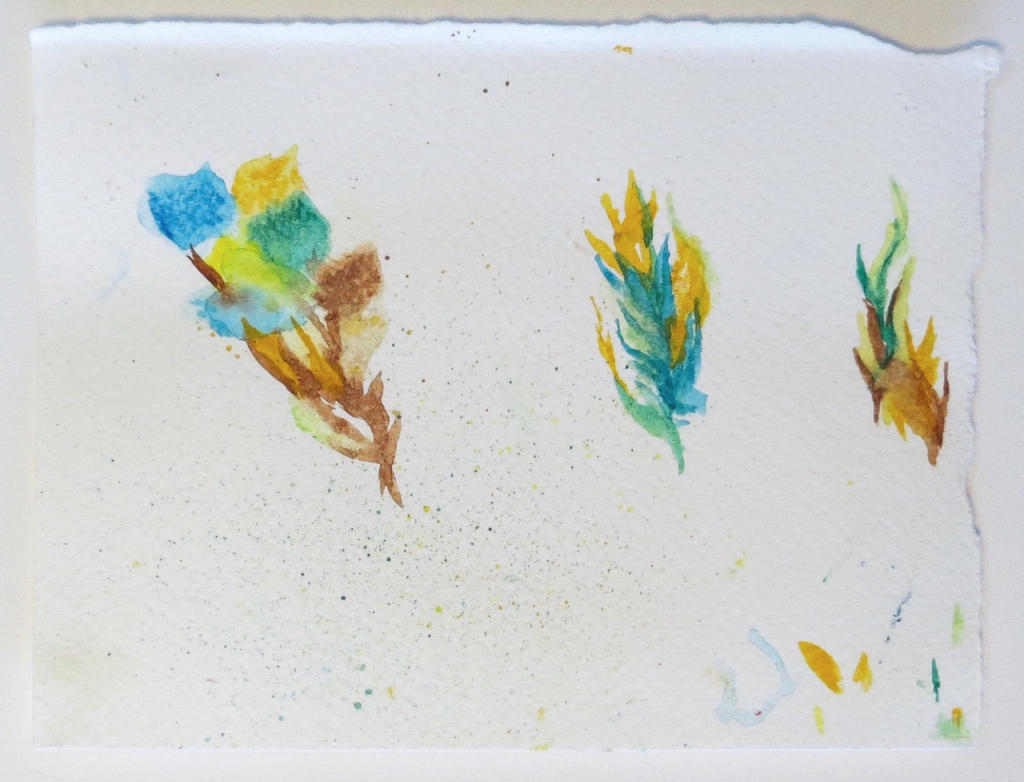
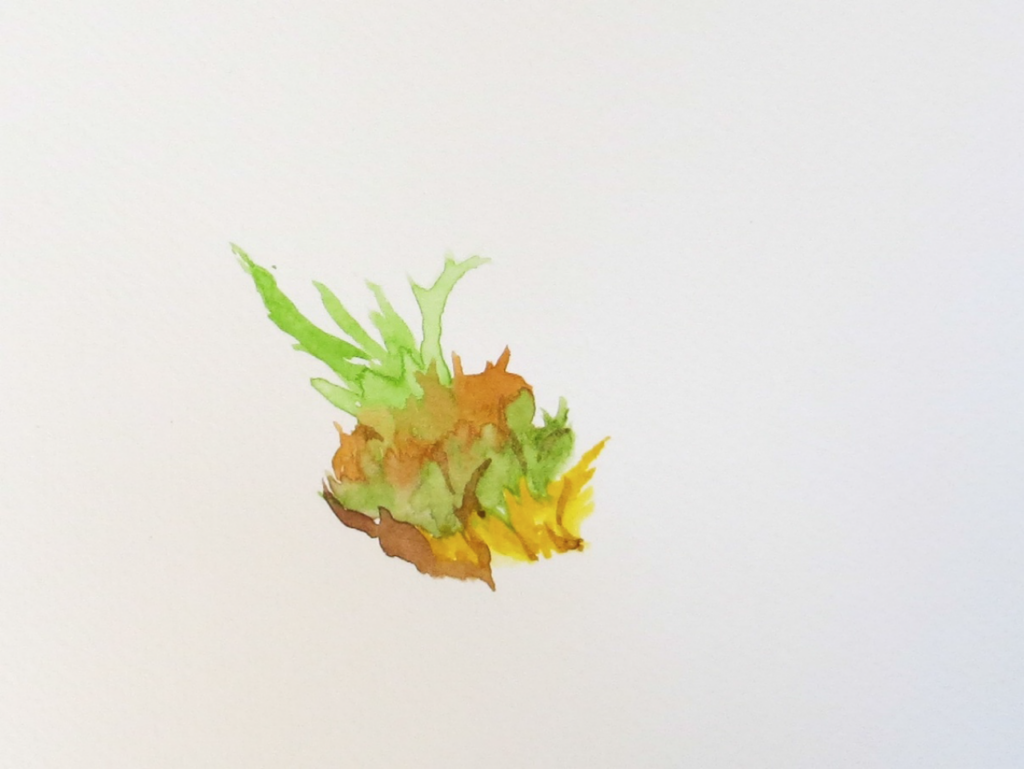
Jen Bradley for Art in Healthcare
2019
7 May 2019 by
Art in Healthcare
